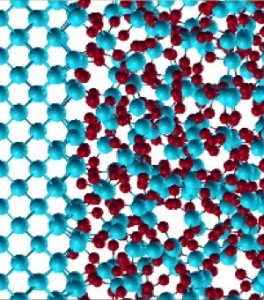Fabiano Corsetti and Arash Mostofi, A first-principles study of As doping at a disordered Si-SiO2 interface, J. Phys.: Condens. Matter 26, 055002 (2014) [ONLINE JOURNAL|PDF]
Understanding the interaction between dopants and semiconductor-oxide interfaces becomes increasingly important as transistors are made smaller and smaller. As part of this work we developed atomistic models of realistic silicon-silica interfaces using a combination of first-principles density-functional theory and a continuous random network Monte Carlo method. We then used these models to study the properties and energetics of segregation of electrically active arsenic donors.
We found that a small percentage (around 10%) of the atomic sites in the first few monolayers on the silicon side of the interface are energetically favourable for segregation, and that this is controlled by the local bonding and local strain of the defect centre. We also found that there is a long-range quantum confinement effect due to the presence of the interface, which results in an energy barrier for dopant segregation, but that this barrier is small in comparison to the effect of the local chemical environment. Finally, we showed that segregation can be controlled by the application of strain to the interface and that this could provide a mechanism for experimental control of dopant segregation in real devices.
This work was part of Fabiano Corsetti’s PhD.
